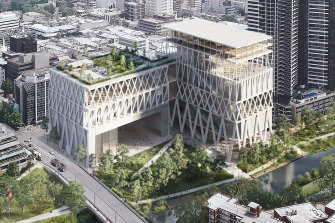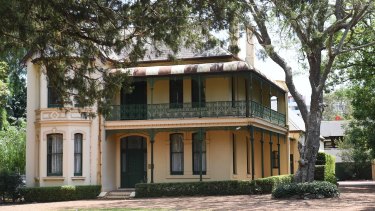The new Powerhouse Museum at Parramatta has been declared a state significant project, in what opponents say gives the Berejiklian government license to override community or council objections to the bulldozing of historic buildings on site.
The new Powerhouse Museum earmarked for the Parramatta River.
The museum's chief executive officer Lisa Havilah also confirmed there would no traditional planetarium in the new museum. Instead a large-scale contemporary, immersive screen space would present science and astronomy programs.
"We are trying to do something even more dynamic than a traditional planetarium," she said. "We are trying to create a space for the future that is flexible, immersive and will continue to present great front-end technology programs for young people for many decades to come."
The designation of state significance bypasses Parramatta Council's development controls and comes as Labor has stepped up their opposition to the billion-dollar project in the wake of the state's "black summer", proposing that taxpayers' contribution of $645 million be diverted to bushfire recovery.
Architectural firms Moreau Kusunoki and Genton were named winners of the international design competition for the museum's future home beside the Parramatta River in Sydney's west. They designed a towering trellis-like structure that would provide open presentation spaces to support exhibitions, live music, and cultural events and festivals, as well as 60 residential units, cafes, and shops.
Infrastructure NSW deemed the project to be of state significance in a letter dated January 13 requesting the Department of Planning start assessment.
Its application specifies demolition of the existing four-level Riverbank car park, Willow Grove and St George's Terrace.
Willow Grove is one of two heritage properties that will be bulldozed to make way for the new museum. Credit:Nick Moir
Built in the 1870s, Willow Grove is an example of a Victorian Italianate two-storey villa and once served as a maternity hospital. Along with St George's Terrace, it is a locally listed heritage item.
Opposition spokesman for the arts and treasury, Walt Secord, predicted the views of the local council, locals and community groups would be subverted by the development process as they were for WestConnex when, he said, the views of the community had been "steamrolled".
"Because the Berejiklian government does not have the community on-board, it will ram the Powerhouse Museum through the approvals process," the shadow treasurer said.
"The Powerhouse Museum is a massive expenditure at a time when the economy is facing tough conditions – the drop in tourism due to the coronavirus, infrastructure cost blow-outs, the recent bushfires and the devastating drought."
Museum consultant Kylie Winkworth said planning for the Parramatta facility had been secretive, compared to Museum of London's open process of community involvement when it proposed shifting premises to the abandoned Smithfield market.
In NSW the public had, had no say in the site selection assessment and on the museum’s themes and content, she said. The public had yet to see the shortlisted competition designs, let alone voice a preference.
Ms Havilah, however, said the community would be actively involved throughout the planning process and the museum's development and programming – informally and formally – to ensure the new museum met the needs of the populace it served. "We look forward to sharing the finalist designs with the public in the near future."
In forging ahead, Infrastructure NSW said the new museum project exhibited design excellence and established a new iconic public building for the Parramatta CBD that would anchor arts and culture in western Sydney.
Local businesses and residents, along with the general public, would be consulted as part of the development process and the environmental impact statement would consider potential environmental, economic and social effects, according to Infrastructure NSW.
Ms Winkworth said the project was not so much a museum for the people but a statement of architecture with the museum's collection deemed unimportant.
"It is much cheaper to deliver with empty spaces than to develop an actual museum with proper exhibitions," she said.
Powerhouse Museum's core exhibitions wrap up in June, with the start of a staged closure of the Ultimo site taking 12 months to complete.
Source: Read Full Article




